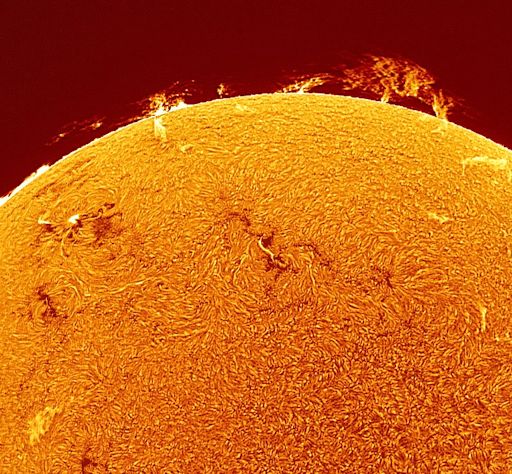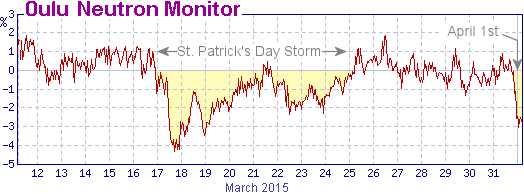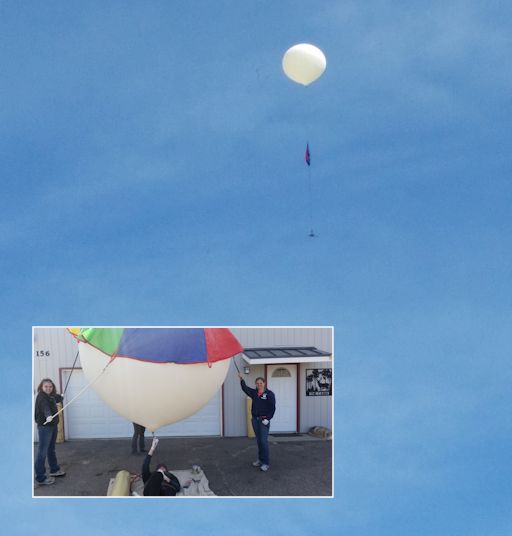Come to Tromsø and share Marianne's passion for rural photography: Chasethelighttours.co.uk invites you to experience "Heaven on Earth" with an aurora, fjord, fishing, whale watching, photography or sightseeing tour. | | | TOTAL ECLIPSE OF THE MOON: On Saturday morning, April 4th, sky watchers in the USA can see a brief but beautiful total eclipse of the Moon. The event will also be visible from Mexico, western Canada, across the entire Pacific Ocean, Australia, Indonesia, and elsewhere. View an animated eclipse map from ShadowAndSubstance.com. BIG SOLAR PROMINENCES: The face of the sun is quiet; no sunspots are flaring. The edge of the sun is a different matter. Amateur astronomers are monitoring a network of huge prominences rising above the sun's western limb. Bill Hrudey sends this picture from the Cayman Islands: 
"I used a Lunt solar telescope to photograph these interesting prominences," says Hrudey. Prominences are massive plumes of hot plasma held above the surface of the sun by magnetic force fields. Frequently, these magnetic fields become unstable and erupt, hurling billions of tons of hot gas into space. Got a solar telescope? Monitoring is encouraged. Solar flare alerts: text, voice Realtime Space Weather Photo Gallery FORBUSH DECREASE: For the second time in two weeks, a Forbush Decrease is underway. In other words, the number of cosmic rays around Earth is down. Note the sudden drop in counts on April 1st in these data from the neutron monitor in Oulu, Finland: 
Forbush decreases happen when CMEs sweep past Earth and push aside cosmic rays that normally surround our planet. A CME that hit Earth on March 17th, St. Patrick's Day, triggered the strongest geomagnetic storm of the current solar cycle. The corresponding Forbush Decrease lasted for days. The Forbush Decrease of April 1st probably won't be as deep or long-lasting. It was caused by a minor interplanetary shock wave that swept past Earth on March 31st; the shock wave's impact was weak and did not even spark a geomagnetic storm. Nevertheless, it did cause a reduction in cosmic rays. To investigate the Forbush Decrease, Spaceweather.com and the students of Earth to Sky Calculus launched a "Space Weather Buoy" (sub-orbital helium balloon) with 4 radiation sensors onboard: 
Soon, we will see if radiation levels in the stratosphere are tracking the ground-based neutron monitor counts. The balloon flight will also probe the effect of the Forbush Decrease at aviation altitudes. Stay tuned.
Realtime Aurora Photo Gallery
Realtime Eclipse Photo Gallery
Realtime Comet Photo Gallery
Every night, a network of NASA all-sky cameras scans the skies above the United States for meteoritic fireballs. Automated software maintained by NASA's Meteoroid Environment Office calculates their orbits, velocity, penetration depth in Earth's atmosphere and many other characteristics. Daily results are presented here on Spaceweather.com. On Apr. 1, 2015, the network reported 50 fireballs.
(50 sporadics)  In this diagram of the inner solar system, all of the fireball orbits intersect at a single point--Earth. The orbits are color-coded by velocity, from slow (red) to fast (blue). [Larger image] [movies] Potentially Hazardous Asteroids ( PHAs) are space rocks larger than approximately 100m that can come closer to Earth than 0.05 AU. None of the known PHAs is on a collision course with our planet, although astronomers are finding new ones all the time. On April 1, 2015 there were 1569 potentially hazardous asteroids. Notes: LD means "Lunar Distance." 1 LD = 384,401 km, the distance between Earth and the Moon. 1 LD also equals 0.00256 AU. MAG is the visual magnitude of the asteroid on the date of closest approach. | | The official U.S. government space weather bureau | | | The first place to look for information about sundogs, pillars, rainbows and related phenomena. | | | Researchers call it a "Hubble for the sun." SDO is the most advanced solar observatory ever. | | | 3D views of the sun from NASA's Solar and Terrestrial Relations Observatory | | | Realtime and archival images of the Sun from SOHO. | | | from the NOAA Space Environment Center | | | the underlying science of space weather | | 
